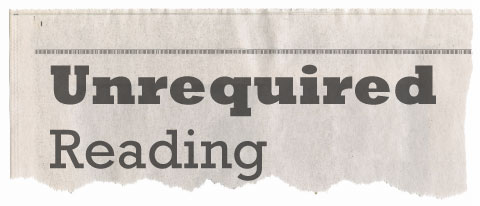
These are some of the things that have caught my attention lately. It’s a more eclectic mix than just the news business, but then so’s life:
- Will Google Buy The New York Times? | SpliceToday.com – A new favorite recipe for salvation that’s kicked around the blogosphere involves none other than Google. The Times has an estimated price tag of $3 to $4 billion. (Rupert Murdoch paid $5 billion for Dow Jones, The Wall Street Journal’s parent company.) A fistful of billions, even in this economy, might not be too big of a dent in Google’s bottom line and, it’s argued, the ends would soon pay back the means. The anonymous blogger at Dear John Thain divided his pro-acquisition reasons into four points: it would give Google an even more highly integrated advertising model; if Google distributes the Times, it takes in the paper’s ad revenue while also moving the medium away from dead trees; the Times’ push to personalize content couldn’t be better supported by Google; the Times’ product—the news—is priceless, and it would benefit Google and the rest of us if it stayed available.
All valid points, but none that take into account the irrationality of immovable human devotion. The Sulzberge
- About those scatterplots . . . | Social Science Statistics Blog – The audience at the talk, much of which studies the media in some capacity and nearly all of which reads the NYT, seemed hungry for some analysis of the economics behind the paper's decision to invest so much in graphics. (Amanda said the paper spends $500,000 a month on the department.) Amanda wasn't really able to shed too much light on this, but said she felt very fortunate to be at a paper that lets her publish regression trees when, at many papers, the graphics team is four people who have their hands full producing "fun facts" sidebars and illustrations of car crash sites.
- Financing the Future of Journalism | Columbia Business School – Right now, almost all newspaper content that appears on the Web is free. The newspaper industry has been trading advertising dollars for Internet cents. How does it turn those Internet cents into Internet dollars? Or, simply, how does it get direct money from its users?
One discussion I’ve had with students here at Columbia Business School is about creating an earned-income model for the newspaper industry along the lines of Skype, where users make micropayments.
I check the New York Times five to 10 times a day on my Blackberry, for example, and I don’t pay a cent for that content. Is there a way for the Times and other newspapers — especially local newspapers, where there is high value for the reader — to create a micropayment each time a reader checks the site?
Multiply those small amounts by millions of users and it adds up to a serious amount of money. Direct micropayments are part of the solution, but experts must first create a model for them.
- Newsweek: Team of Rivals | The Big Picture – [W]hat’s unique about the Economist is that it speaks with one editorial voice. There are no bylines at the Economist. (With the exception of the book reviews.)
Newsweek, on the other hand, is magazine that can barely contain its internal tensions…
- Jean Charles de Menezes inquest: Jury reaches open verdict | Telegraph – During 12 weeks of evidence the inquest at the Oval cricket ground in south London heard from dozens of police officers who painted a picture of chaos and confusion within the 'Gold Command’ control room at Scotland Yard on the day in question.
Despite none of the 10 surveillance officers who followed Mr de Menezes positively identifying him as suicide bomber Hussain Osman, senior officers were given the impression that he had been identified as the suicide bombing suspect.
The inquest also heard that good quality photographs of Osman which had been found with his failed home-made bomb were not given to the surveillance officers, meaning they had to rely on grainy, indistinct CCTV images, and passengers on the Tube train all said the police did not shout a warning to the Brazilian electrician which would have given him the chance to surrender himself before they shot him. - WUSA to Hire ‘Multimedia Journalists’ Who Work Solo | washingtonpost.com – For decades, TV journalists have worked in teams, with the lines of responsibility regulated by union rules or simple tradition. Stories were covered by a crew consisting of a camera operator and a correspondent (and further back, by a sound or lighting technician); their work was overseen by a producer and their footage assembled into a finished story by an editor.
But technology — handheld or tripod-mounted cameras, laptop editing programs and the Internet — have made it possible for one person to handle all those assignments, station managers say.